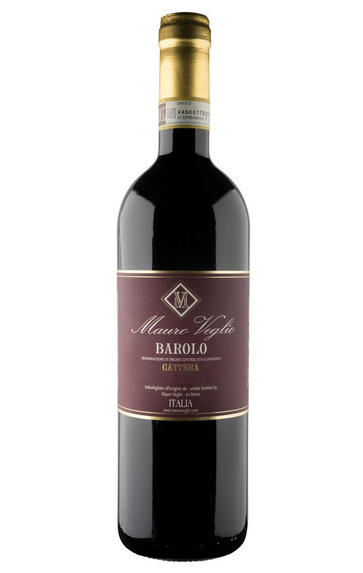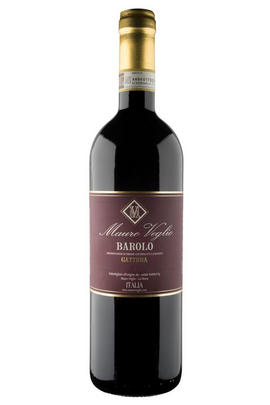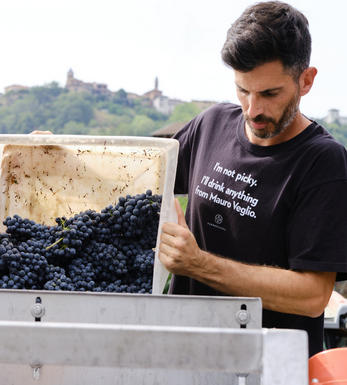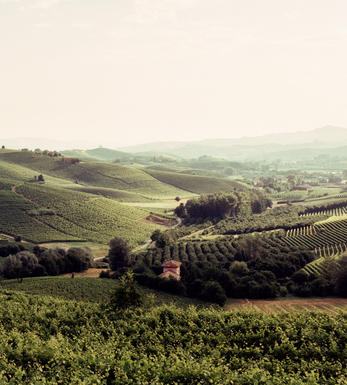
2018 Barolo, Gattera, Mauro Veglio, Piedmont, Italy

Critics reviews
The 2018 Barolo Gattera marries the natural exuberance of this site with a feeling of translucence I have not seen here previously. This is the first vintage that blends Mauro Veglio's south-facing parcel with Alessandro Veglio's south-east facing piece, a combination that works so well. Dark cherry, plum, spice, lavender and licorice infuse the 2018 with layers of nuance. The 2018 is beautifully done. Moreover, the 2018 bodes very well for the future.
Drink 2024 - 2038
Antonio Galloni, vinous.com (Feb 2022)
La Morra. Much hotter site than Arborina. 'We have two plots, one plain south, which ends mostly in the classico, the one facing south-west goes into the cru.' Both plots were planted at the beginning of the 1950s.
Lustrous mid ruby with orange tinges. Full firm nose of ripe cherry fruit with just a touch of savoury oak. Lots of ripe sour-cherry and raspberry fruit on the palate. The ripe grainy tannic charge is perfectly aligned with the generous fruit. Very long and fruit-driven but still in its infancy. The tannins are like tiny pebbles on a gravel road cutting through the fruit.
Drink 2022 - 2030
Walter Speller, jancisrobinson.com (Nov 2021)
Enticing, spicy red-fruit nose, then a medium-bodied palate with some focused spice to the lightly firm tannins. Try from 2023.
James Suckling, jamessuckling.com (Jan 2022)
About this WINE

Mauro Veglio
Mauro Veglio is situated in the hamlet of Cascina Nuova, near the road that winds down from La Morra. It was founded in the 1960s, when Angelo Veglio bought his first vines in Gattera. In ’79, the family moved to Cascina Nuova, which came with five hectares of vines including holdings in the crus Arborina and Rocche dell’Annunziata. In ’86, Angelo’s son Mauro took over. His marriage in ’87 added holdings in Castelletto, Monforte, to the estate. In 2017, a family alliance with Mauro’s nephew Alessandro – already running his own winery – brought a further five hectares in Gattera and Paiagallo. Today, the estate spans nearly 30 hectares. Leading modernist Elio Altare’s winery is across the yard; he was a strong influence in Mauro’s early days. But under Alessandro’s vision, there is greater flexibility: less accent on extraction and more ageing in larger barrels, although barriques are still used judiciously.
This is Alessandro’s first vintage for his Serralunga project, which enhances both his Classico blend and introduces his Commune di Serralunga. Now, he has Barolo offerings from four of the region’s communes. He has also acquired three hectares of the white Timorasso grape in Tortona, as well as a little more land in Paiagallo from 2023, making his ambition evident. The clear yet defined tannic structure of the 2019 vintage has encouraged him to further reduce the percentage of new oak in the crus where it is used, and botte are again more to the fore. It was also interesting to note that the wines aged in barriques appeared more open, compared to addresses where the wines had been slower to evolve in botte..

Barolo
Located due south of Alba and the River Tanaro, Barolo is Piedmont's most famous wine DOCG (Denominazione di Origine Controllata e Garantita), renowned for producing Italy's finest red wines from 100 percent Nebbiolo.
Its red wines were originally sweet, but in 1840 the then extant Italian monarchy, the House of Savoy, ordered them to be altered to a dry style. This project was realised by French oenologist Louis Oudart, whose experience with Pinot Noir had convinced him of Nebbiolo's potential. The Barolo appellation was formalised in 1966 at around 1,700 hectares – only a tenth of the size of Burgundy, but almost three times as big as neighbouring Barbaresco.
Upgraded to DOCG status in 1980, Barolo comprises two distinct soil types: the first is a Tortonian sandy marl that produces a more feminine style of wine and can be found in the villages of Barolo, La Morra, Cherasco, Verduno, Novello, Roddi and parts of Castiglione Falletto. The second is the older Helvetian sandstone clay that bestows the wines with a more muscular style. This can be found in Monforte d'Alba, Serralunga d'Alba, Diano d'Alba, Grinzane Cavour and the other parts of Castiglione Falletto. Made today from the Nebbiolo clones Lampia, Michet and Rosé, Barolo has an exceptional terroir with almost every village perched on its own hill. The climate is continental, with an extended summer and autumn enabling the fickle Nebbiolo to achieve perfect ripeness.
Inspired by the success of modernists such as Elio Altare, there has been pressure in recent years to reduce the ageing requirements for Barolo; this has mostly been driven by new producers to the region, often with no Piedmontese viticultural heritage and armed with their roto-fermenters and barriques, intent on making a fruitier, more modern style of wine.
This modern style arguably appeals more to the important American market and its scribes, but the traditionalists continue to argue in favour of making Barolo in the classic way. They make the wine in a mix of epoxy-lined cement or stainless-steel cuves, followed by extended ageing in 25-hectoliter Slavonian botte (barrels) to gently soften and integrate the tannins. However, even amongst the traditionalists there has been a move, since the mid-1990s, towards using physiologically (rather than polyphenolically) riper fruit, aided by global warming. Both modernist and traditional schools can produce exceptional or disappointing wines.
Recommended traditionalist producers:
Giacomo Borgogno, Giacomo Conterno, Bruno Giacosa, Elio Grasso, Marcarini, Bartolo Mascarello and Giuseppe Mascarello.
Recommended nmdernist producers:
Azelia, Aldo Conterno, Luciano Sandrone, Paolo Scavino and Roberto Voerzio

Nebbiolo
Nebbiolo is the grape behind the Barolo and Barbaresco wines and is hardly ever seen outside the confines of Piedmont. It takes its name from "nebbia" which is Italian for fog, a frequent phenomenon in the region.
A notoriously pernickety grape, it requires sheltered south-facing sites and performs best on the well-drained calcareous marls to the north and south of Alba in the DOCG zones of Barbaresco and Barolo.
Langhe Nebbiolo is effectively the ‘second wine’ of Piedmont’s great Barolo & Barbarescos. This DOC is the only way Langhe producers can declassify their Barolo or Barbaresco fruit or wines to make an early-drinking style. Unlike Nebbiolo d’Alba, Langhe Nebbiolo can be cut with 15% other red indigenous varieties, such as Barbera or Dolcetto.
Nebbiolo flowers early and ripens late, so a long hang time, producing high levels of sugar, acidity and tannins; the challenge being to harvest the fruit with these three elements ripe and in balance. The best Barolos and Barbarescos are perfumed with aromas of tar, rose, mint, chocolate, liquorice and truffles. They age brilliantly and the very best need ten years to show at their best.


Buying options
Add to wishlist
Description
Lower on the slope and near the Castiglione Falletto border, there’s more limestone in the Gattera cru. This has the estate’s oldest vines; always the first to be picked. It has a glorious fruity bouquet of wild strawberry, full of juicy accessibility. Alessandro was able to retain about 30% of whole bunch for the fermentation, so the edges of the wine appear softer. Drink 2025-2038.
Mark Pardoe MW, Wine Director, Berry Bros. & Rudd (Mar 2022)
wine at a glance
Delivery and quality guarantee